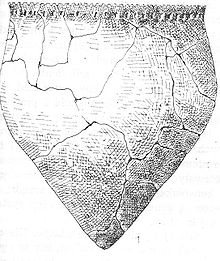Narva culture
The Narva culture was a semi- Neolithic culture in the 5th to 4th millennium BC. BC ( Forest Neolithic ), which can be found from Estonia in the north via Latvia and Lithuania to the former East Prussia in the south. The Narva culture developed from the Mesolithic Kunda culture .
Surname
The culture is named after localities on the banks of the Narva River , which forms the border between Estonia and Russia , and was named after the city of Narva , according to Marija Gimbutas .
Characteristics
The economy of the Narva culture was based on hunting and gathering . Finds of bones and antler artefacts document the hunt for birds , fish , seals and land mammals . Especially in comparison with the simultaneous, southern Nemunas culture , the flint did not play an important role. There are also hoes, spout axes and hand grinders , so that planting seems possible. The culture knew clay processing . A connection in the design of pointed-bottom ceramics is seen with the comb ceramics culture .
variants
At the time of the Schnurkeramik , developed in East Prussia as a Haffküsten culture , two variants are distinguished:
- the northeast variant seems to have remained autonomous. Possibly she belonged to the Urals language family .
- the south-western one shows elements of the earlier funnel beaker culture as well as the later cord ceramic and the spherical amphora culture . Huld and Bley want to relate the southwestern variant to Proto- Baltic , the forerunner of Latvian , Lithuanian and Prussian , but this remains speculative. The largest cemetery excavated to date is the Zvejnieki cemetery .
literature
- Martin E. Huld, Karlene Jones-Bley (Eds.): The Indo-Europeanization of Northern Europe. Institute for the Study of Man, Washington DC 1996, ISBN 0-941694-52-6 ( Journal of Indo-European Studies. Monographs No. 17).
Web links
- Formation and development of the Stone Age settlement at Riigiküla, Northeastern Estonia (Aivar Kriiska)
- The Introduction of Ceramic Technology Around the Baltic Sea in the 6th Millennium (Fredrik Hallgren; PDF file; 1.15 MB)
